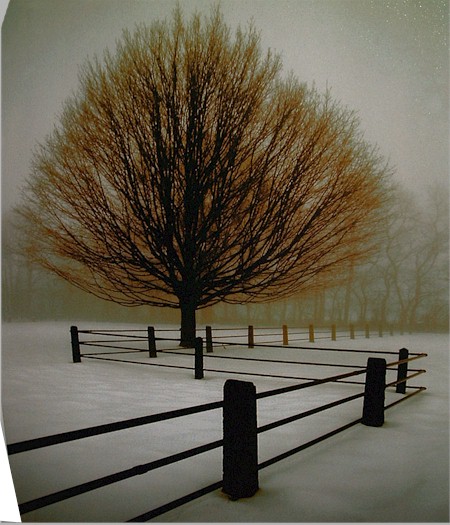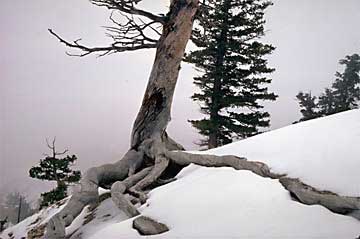 I love the work of photographer David Lorenz Winston, so when I saw what looked to be an original oil painting by him entitled “Solitude”, at an unbelievably low price, I couldn’t believe my eyes. I was right not to — it wasn’t an oil, but a giclÈe print of a photograph on a textured gloss or surface-treated canvas, so it looked, at least to my untrained eye, like an original oil. It glimmers in the light and reflects light off the sides of the pigment as you move, just like hand-painted oil or acrylic. GiclÈe (invented by rocker Graham Nash) is like inkjet on steroids — 12-colour hi-res inkjet copies produced one-off from a digital master. By contrast, most prints use lithography — an upscale dot-matrix technology but with only four colours used and relatively poor resolution. The combination of giclÈe and gloss/surface treated canvas is a great example of innovation, and I commend the studio, Northland Art Company, for using it. The photo above (excuse the warp — my lousy photography) is taken from the giclÈe-on-canvas print; a plain print by Winston from his website is below. You can get an idea by comparing them of the richness and three-dimensionality that this ultra-high-resolution colour and stippling effect adds. When a photographer doctors his shot, unless it’s very clever and artistic we’re inclined to call it fraud. But when an artist uses paint or watercolour to portray something in a distorted, exaggerated or surreal way, whether it’s real or imagined, we call it art. The distributor at Northland said the process can double the walk-by sales of a print. And the process can make a poor art collector look like an affluent collector of originals. Now I’m wondering if it would be possible to take some of my ‘flat’ prints and either surface-treat them, and/or re-print them onto textured canvas, so they look like the original watercolours, oils or acrylics instead of just prints. Any artists tell me if that’s possible? And what are the ethical issues of re-printing (for personal use only) or surface-treating a signed print — does this open up the same issues for the art world that digital copying and file-sharing have produced for musicians and film-makers? |
Navigation
Collapsniks
Albert Bates (US)
Andrew Nikiforuk (CA)
Brutus (US)
Carolyn Baker (US)*
Catherine Ingram (US)
Chris Hedges (US)
Dahr Jamail (US)
Dean Spillane-Walker (US)*
Derrick Jensen (US)
Dougald & Paul (IE/SE)*
Erik Michaels (US)
Gail Tverberg (US)
Guy McPherson (US)
Honest Sorcerer
Janaia & Robin (US)*
Jem Bendell (UK)
Mari Werner
Michael Dowd (US)*
Nate Hagens (US)
Paul Heft (US)*
Post Carbon Inst. (US)
Resilience (US)
Richard Heinberg (US)
Robert Jensen (US)
Roy Scranton (US)
Sam Mitchell (US)
Tim Morgan (UK)
Tim Watkins (UK)
Umair Haque (UK)
William Rees (CA)
XrayMike (AU)
Radical Non-Duality
Tony Parsons
Jim Newman
Tim Cliss
Andreas Müller
Kenneth Madden
Emerson Lim
Nancy Neithercut
Rosemarijn Roes
Frank McCaughey
Clare Cherikoff
Ere Parek, Izzy Cloke, Zabi AmaniEssential Reading
Archive by Category
My Bio, Contact Info, Signature Posts
About the Author (2023)
My Circles
E-mail me
--- My Best 200 Posts, 2003-22 by category, from newest to oldest ---
Collapse Watch:
Hope — On the Balance of Probabilities
The Caste War for the Dregs
Recuperation, Accommodation, Resilience
How Do We Teach the Critical Skills
Collapse Not Apocalypse
Effective Activism
'Making Sense of the World' Reading List
Notes From the Rising Dark
What is Exponential Decay
Collapse: Slowly Then Suddenly
Slouching Towards Bethlehem
Making Sense of Who We Are
What Would Net-Zero Emissions Look Like?
Post Collapse with Michael Dowd (video)
Why Economic Collapse Will Precede Climate Collapse
Being Adaptable: A Reminder List
A Culture of Fear
What Will It Take?
A Future Without Us
Dean Walker Interview (video)
The Mushroom at the End of the World
What Would It Take To Live Sustainably?
The New Political Map (Poster)
Beyond Belief
Complexity and Collapse
Requiem for a Species
Civilization Disease
What a Desolated Earth Looks Like
If We Had a Better Story...
Giving Up on Environmentalism
The Hard Part is Finding People Who Care
Going Vegan
The Dark & Gathering Sameness of the World
The End of Philosophy
A Short History of Progress
The Boiling Frog
Our Culture / Ourselves:
A CoVid-19 Recap
What It Means to be Human
A Culture Built on Wrong Models
Understanding Conservatives
Our Unique Capacity for Hatred
Not Meant to Govern Each Other
The Humanist Trap
Credulous
Amazing What People Get Used To
My Reluctant Misanthropy
The Dawn of Everything
Species Shame
Why Misinformation Doesn't Work
The Lab-Leak Hypothesis
The Right to Die
CoVid-19: Go for Zero
Pollard's Laws
On Caste
The Process of Self-Organization
The Tragic Spread of Misinformation
A Better Way to Work
The Needs of the Moment
Ask Yourself This
What to Believe Now?
Rogue Primate
Conversation & Silence
The Language of Our Eyes
True Story
May I Ask a Question?
Cultural Acedia: When We Can No Longer Care
Useless Advice
Several Short Sentences About Learning
Why I Don't Want to Hear Your Story
A Harvest of Myths
The Qualities of a Great Story
The Trouble With Stories
A Model of Identity & Community
Not Ready to Do What's Needed
A Culture of Dependence
So What's Next
Ten Things to Do When You're Feeling Hopeless
No Use to the World Broken
Living in Another World
Does Language Restrict What We Can Think?
The Value of Conversation Manifesto Nobody Knows Anything
If I Only Had 37 Days
The Only Life We Know
A Long Way Down
No Noble Savages
Figments of Reality
Too Far Ahead
Learning From Nature
The Rogue Animal
How the World Really Works:
Making Sense of Scents
An Age of Wonder
The Truth About Ukraine
Navigating Complexity
The Supply Chain Problem
The Promise of Dialogue
Too Dumb to Take Care of Ourselves
Extinction Capitalism
Homeless
Republicans Slide Into Fascism
All the Things I Was Wrong About
Several Short Sentences About Sharks
How Change Happens
What's the Best Possible Outcome?
The Perpetual Growth Machine
We Make Zero
How Long We've Been Around (graphic)
If You Wanted to Sabotage the Elections
Collective Intelligence & Complexity
Ten Things I Wish I'd Learned Earlier
The Problem With Systems
Against Hope (Video)
The Admission of Necessary Ignorance
Several Short Sentences About Jellyfish
Loren Eiseley, in Verse
A Synopsis of 'Finding the Sweet Spot'
Learning from Indigenous Cultures
The Gift Economy
The Job of the Media
The Wal-Mart Dilemma
The Illusion of the Separate Self, and Free Will:
No Free Will, No Freedom
The Other Side of 'No Me'
This Body Takes Me For a Walk
The Only One Who Really Knew Me
No Free Will — Fightin' Words
The Paradox of the Self
A Radical Non-Duality FAQ
What We Think We Know
Bark Bark Bark Bark Bark Bark Bark
Healing From Ourselves
The Entanglement Hypothesis
Nothing Needs to Happen
Nothing to Say About This
What I Wanted to Believe
A Continuous Reassemblage of Meaning
No Choice But to Misbehave
What's Apparently Happening
A Different Kind of Animal
Happy Now?
This Creature
Did Early Humans Have Selves?
Nothing On Offer Here
Even Simpler and More Hopeless Than That
Glimpses
How Our Bodies Sense the World
Fragments
What Happens in Vagus
We Have No Choice
Never Comfortable in the Skin of Self
Letting Go of the Story of Me
All There Is, Is This
A Theory of No Mind
Creative Works:
Mindful Wanderings (Reflections) (Archive)
A Prayer to No One
Frogs' Hollow (Short Story)
We Do What We Do (Poem)
Negative Assertions (Poem)
Reminder (Short Story)
A Canadian Sorry (Satire)
Under No Illusions (Short Story)
The Ever-Stranger (Poem)
The Fortune Teller (Short Story)
Non-Duality Dude (Play)
Your Self: An Owner's Manual (Satire)
All the Things I Thought I Knew (Short Story)
On the Shoulders of Giants (Short Story)
Improv (Poem)
Calling the Cage Freedom (Short Story)
Rune (Poem)
Only This (Poem)
The Other Extinction (Short Story)
Invisible (Poem)
Disruption (Short Story)
A Thought-Less Experiment (Poem)
Speaking Grosbeak (Short Story)
The Only Way There (Short Story)
The Wild Man (Short Story)
Flywheel (Short Story)
The Opposite of Presence (Satire)
How to Make Love Last (Poem)
The Horses' Bodies (Poem)
Enough (Lament)
Distracted (Short Story)
Worse, Still (Poem)
Conjurer (Satire)
A Conversation (Short Story)
Farewell to Albion (Poem)
My Other Sites


 Winston’s work looks almost surreal, as if it were photoshopped, but the giclÈe-on-canvas (close up sample at right) seems to restore its ‘authenticity’, by psychologically transforming it from a photo (a mechanical reproduction), to a painting (a
Winston’s work looks almost surreal, as if it were photoshopped, but the giclÈe-on-canvas (close up sample at right) seems to restore its ‘authenticity’, by psychologically transforming it from a photo (a mechanical reproduction), to a painting (a 



Sorry, not a comment exactly related to to post. I have a family member who’s trying to blow the whistle on a major polluter, and I’d like to help him. There are some hints on my site about what’s going on; more should follow soon. Just wanted to say hi (you may remember me from a some months back, before I stopped blogging) and that I’d appreciate any advice you have as the story unfolds.
Gah, the has been bumped way down; it’s at http://blogs.salon.com/0002599/2004/06/24.html#a351
first thing, photoshop, doctor and process all you want. you, artist or not, have the right to do whatever is required so that your object most closely represents your idea. if you’re an artist, that becomes also a responsibility. unless of course if you’re saying, explicitly, “here is objective reality”, and who bothers with that anymore.photos on canvas are ok but, um, they conflict with my objective reality as not so photographic. or something. i do like to print on heavy , cold pressed watercolor papers.assuming you’re talking digital prints, both watercolor papers and canvas, ready for inkjet, are available.
Harrison: My only advice is to have the victims quickly obtain advice from both a law firm with a record of prosecuting environmentally irresponsible companies and an advocacy agency to help with the research. I am concerned that GLCC’s and the EPA’s immediate reaction is going to be to threaten libel action against McKinnon for the serious claims he makes, unless he has hard evidence — a standard scare tactic of polluters. A good place to start might be contacting Robert Kennedy Jr.’s organization NRDC.
Thanks! I know they are using a law firm — don’t know anything about its track record on environmental issues. I’ve talked to a number of relatives who’ve worked for the place, and I what I’ve heard is horrifying.